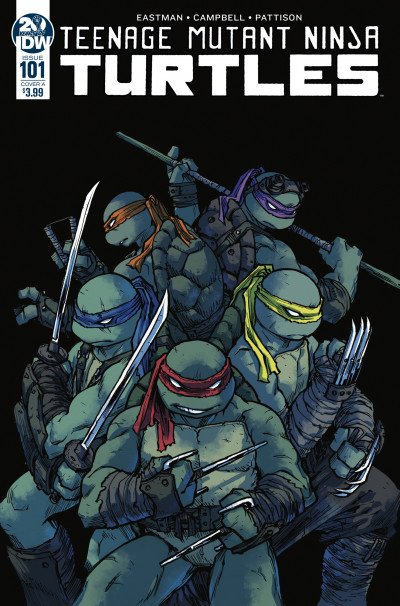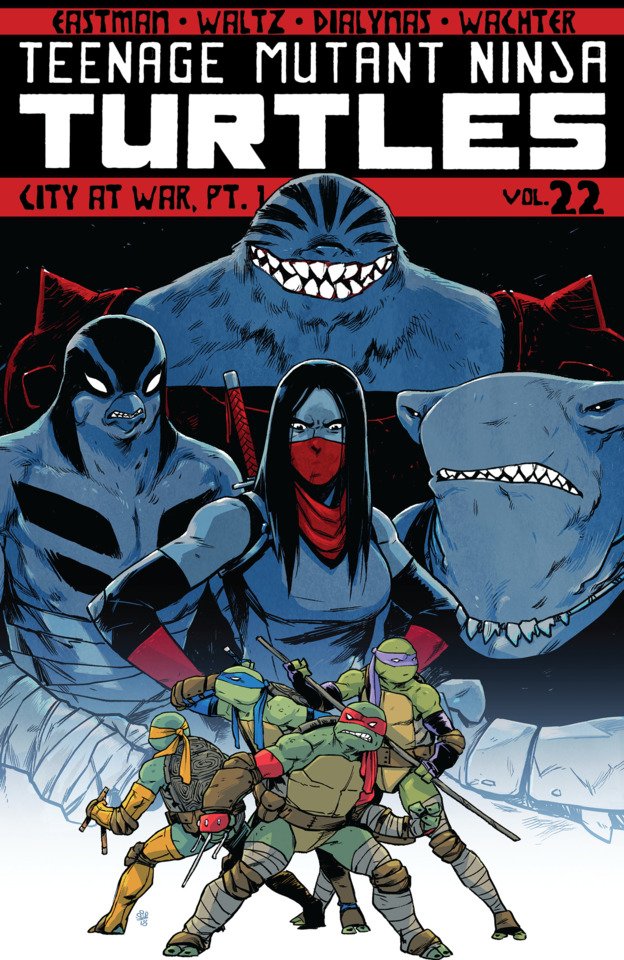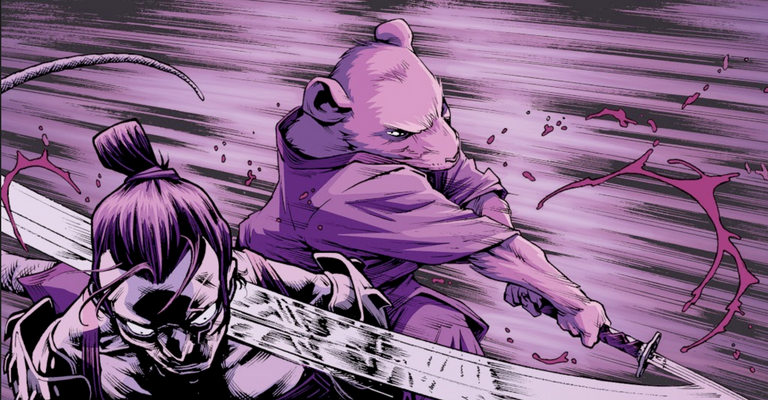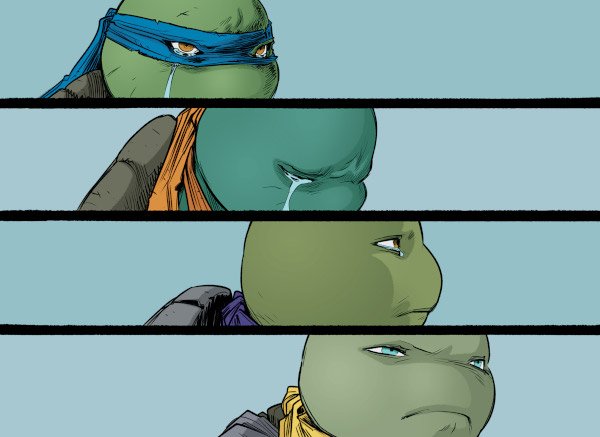City At War Ends In Tragedy. With Splinter Gone, The Turtles Must Work Through Their Grief and Forge A Path Forward.
My last experience with Saturday morning childhood heroes, The Teenage Mutant Ninja Turtles, was their awful film remakes of the same name in 2014 and the sequel of 2016. But other than those, I hadn't paid much attention to their ongoing comic series on IDW publishing, despite some enticing crossovers with Batman and Usagi Yojimbo. But The Last Ronin was a title that piqued my interest, seeming to offer up an edgier and darker take on the heroes that graced our screens on Saturday mornings, and as such, I was more than happy to dive into the story and join these old and beloved turtles on yet another adventure.
Yet, after reading The Last Ronin, I realized that I was painfully behind with regards to the story of the Turtles, the result of which made it hard to fully appreciate the circumstances and characters of this latest title. So while this was originally meant to be a review of TLR, I felt I needed to go back and reacquaint myself with the Turtles for the present circumstances to make more sense. While no particular series is offered up as good pre-reading, I decided that the latest TMNT series would suffice, and this is precisely how I would come to land on the various arcs leading to issue #101 and beyond.
Note: Spoilers Ahead
The Teenage Mutant Ninja Turtles is an ongoing series that started in 2011 with Kevin Eastman and Tom Waltz on writing duty and Dan Duncan handling the artwork. Before issue #101, a series of important events had taken place, which is crucial as to future developments. These would include:
- The Death of The Shredder At the Hands of Master Splinter in an honorable Foot Clan Combat Ritual: The victory would give Splinter control of the Foot Clan, a result that even the Shredder's granddaughter, Oroku Karai, would respect and honor.
A Declaration of War: Despite being on good terms with Oroku Karai, Splinter's decision to give refuge to orphaned children within the Foot Clan without conscripting them into its ranks would result in Karai formally challenging his authority. The refusal of ritual combat in The Gauntlet would result in one of the best arcs in the series, City At War.
A New Addition To the Group: One of Master Splinter's most trusted warriors and protégé's, Jennika, would sustain a near-fatal wound at the hands of Karai, necessitating an emergency blood transfusion with Leonardo. Effectively healing her, but simultaneously turning her into a turtle. She would eventually take on the role of the yellow Ninja Turtle, complete with wolverine style claw gloves.
Actors and Aftermath Of the War: Aside from Splinter's Foot Clan and those loyal to Karai, two other factions would involve themselves in the war. On the one hand, a human extremist group called the Earth Protection Force, a group bent on destroying mutants. Similarly, a mutant extremist group called the Mutanimals would focus their efforts on striking back at the humans that had killed and tortured so many of them for so long.
The Death of Master Splinter And the Erection of Mutant Town: Master Splinter would give his life to save his sons and their city from all the forces that came down upon them. Along with this, the mutant bomb released by the leader of the Mutanimals, Old Hob, would transform humans into mutants too, requiring the mayor to section off part of the city as an extreme quarantine measure, a part which would go on to be called Mutant Town.
Now
With the death of their master and father, the Ninja Turtles would hang up their masks and weapons and each attempt to make sense of their loss. Rafael would leave his family to become a vigilante in Mutant Town, Michelangelo would dedicate his time to looking after a new pet cat, Leonardo would distract himself with plants in his greenhouse, while Donatello would document their developments and his activities and mental state in a journal. Other crucial members would do what they could to help out those in Mutant Town as an attempt at keeping busy and finding some form of purpose.Individuals like Jennika would try to come to terms with a her own transformation and her separation from the Foot Clan by helping out struggling mutants and those humans who had been abandoned after their transformation.
With time, the brothers would finally come together and work to carve out a new path for themselves. They would decide to honor their father by erecting The Splinter Clan Dojo, in the hopes of arming the citizens of Mutant Town with the knowledge on how to defend themselves from the threats both within and without their walls. The series started on an incredible note, the journey that each brother takes to come to grips with their father's passing is both heartbreaking yet understandable and heartwarming.
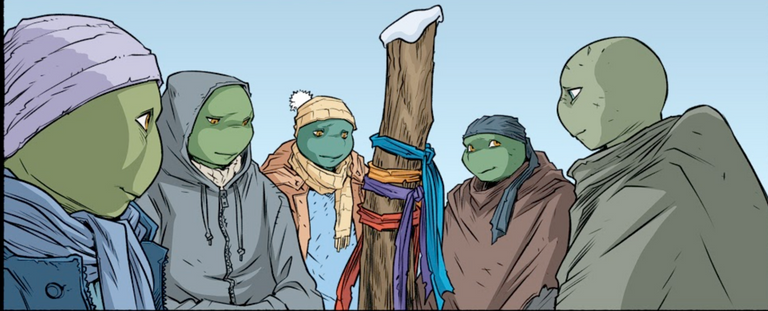
The death of Splinter hits deep, but their ability to rebound together and continue is both inspiring and highly satisfying as far as the story goes. The writers do well to lay the foundation for new challenges to come, and what makes the series unique is its temporary moves away from the typical action-packed adventures of the turtles chasing bad guys, and rather the focus shifts to the Turtles getting their wish of finally joining society as normal additions to it, albeit a unique kind of society. However, they find that the challenges are just as large within their newly adopted home compared to their lives lived as ninjas hiding in the shadows of humanity, for the constructing of a society comes with its own difficulties, from providing effective representation, holding accountable the leaders of the town, providing services for its inhabitants, and creating solid infrastructure along with various institutions for development.
The series as is may not be as exciting as the previous ones, but this is understandable with the Foot Clan recovering from the recent events, and the developments within Mutant Town that require time to build up to more exciting adventures to come. While I felt that the filler issues had the look and feel of after school specials which dampened the initial start, the writers none the less did well in creating fascinating challenges for the characters and readers to work through, including questions of mutant rights, the psychological and social impact of mutant life post transformation and creating scenarios which create other question pertaining to justice and flourishing within Mutant Town.
The writers also entice with small peaks into the nefarious plans of the Foot Clan, the emergence of other potential antagonists and the arrival of fascinating new actors to the story. The arc feels down to earth, and it's refreshing and aside from the serious business of community building, its interesting to see how the brothers handle normal relationships and activities.

One can always rely on comics to give due justice to classics such as TMNT, and IDW publishing has and continues to serve as the perfect platform for the series' growth and maturity in modern times. The comic presents several new dimensions with the addition of new friends and foes and challenges the brothers to develop and hone new skills that their father never taught them. Great things are on the horizon for our favorite turtles, and I for one cannot wait to see how things unfold. A toast to the longevity of the turtles, and a special toast to Master Splinter, may he rest in peace :).
